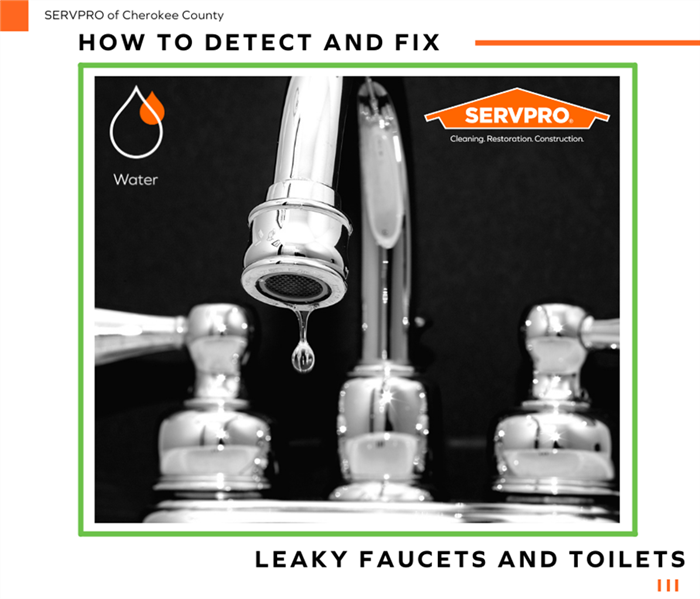How to Detect and Fix Leaky Faucets and Toilets: SERVPRO of Cherokee County
4/24/2023 (Permalink)
 Whether you live in Holly Springs, Canton, Woodstock, or anywhere in between, our local SERVPRO team is here to help 24/7/365.
Whether you live in Holly Springs, Canton, Woodstock, or anywhere in between, our local SERVPRO team is here to help 24/7/365.
Leaky faucets and toilets can cause a range of problems, from increased water bills to water damage in your home. It is essential to detect and fix these issues as soon as possible to prevent the need for costly water damage restoration, mold remediation, and structural repairs. In this guide, we will discuss how to detect leaks and provide step-by-step instructions on fixing them, ultimately saving you time, money, and stress.
Detecting Leaky Faucets and Toilets
- Visual Inspection: The first step in detecting leaks is to conduct a visual inspection of your faucets and toilets. Look for signs of water pooling around the fixtures, dripping water, or damp areas near the pipes.
- Water Meter Check: Turn off all water-using appliances and fixtures in your home, then check the water meter. If the meter is still running, it may indicate a leak in your plumbing system.
- Food Coloring Test: To detect a leaky toilet, add a few drops of food coloring to the toilet tank and wait for about 30 minutes. If the color appears in the bowl, it's a clear indication of a leak.
Fixing Leaky Faucets
- Turn off the Water Supply: Before attempting any repairs, always turn off the water supply to the faucet. This will prevent water damage and ensure a safe working environment.
- Disassemble the Faucet: Remove the faucet handle and any decorative parts to access the inner components. Depending on the type of faucet, you may need to remove a cartridge, a ball, or a compression valve.
- Replace Damaged Parts: Inspect the internal components for signs of wear or damage. Replace any damaged parts, such as O-rings, seals, or washers. In some cases, you may need to replace the entire faucet assembly.
- Reassemble and Test: Reassemble the faucet and turn the water supply back on. Test the faucet for any leaks and ensure it is functioning correctly.
Fixing Leaky Toilets
- Identify the Cause: Leaky toilets can be caused by a variety of issues, such as a damaged flapper, a faulty fill valve, or a cracked overflow tube. Identify the cause of the leak to determine the best course of action.
- Replace the Flapper: If the flapper is damaged or worn, remove it from the flush valve and replace it with a new one. Make sure the new flapper creates a tight seal to prevent water from leaking into the bowl.
- Adjust or Replace the Fill Valve: If the fill valve is the cause of the leak, try adjusting the float level to ensure the water doesn't rise above the overflow tube. If this doesn't resolve the issue, consider replacing the entire fill valve.
- Repair or Replace the Overflow Tube: If the overflow tube is cracked or damaged, you may need to repair it using epoxy or replace it entirely.
Preventing Future Leaks
To prevent the need for water damage restoration or other costly repairs, it's essential to maintain your plumbing system regularly. Here are some tips to help you prevent future leaks:
- Regular Inspections: Conduct regular visual inspections of your faucets and toilets to identify any potential issues early on.
- Routine Maintenance: Replace worn or damaged parts as needed and consider upgrading older fixtures to more efficient models.
- Water Pressure Check: Excessive water pressure can cause leaks and damage to your plumbing system. Install a pressure regulator to ensure the water pressure remains within a safe range.
Detecting and fixing leaky faucets and toilets is crucial for maintaining a healthy and safe home environment. By following these steps, you can prevent water damage, save on water bills, and avoid the need for extensive repairs in the future. However, if you are faced with water damage or need professional assistance with any aspect of water damage restoration, don't hesitate to contact SERVPRO of Cherokee County. Our expert team is trained and equipped to handle water extraction, flood cleanup, dehumidification, mold remediation, structural drying, water damage repair, and disaster recovery. Give us a call at (770) 924-3848 to learn more about our services or to schedule an appointment. Let SERVPRO of Cherokee County help you make it "Like it never even happened."





 24/7 Emergency Service
24/7 Emergency Service